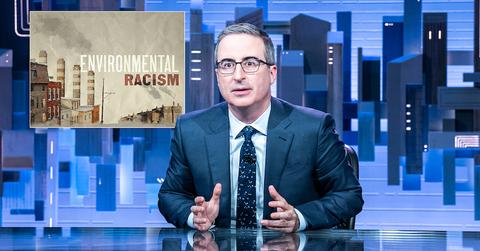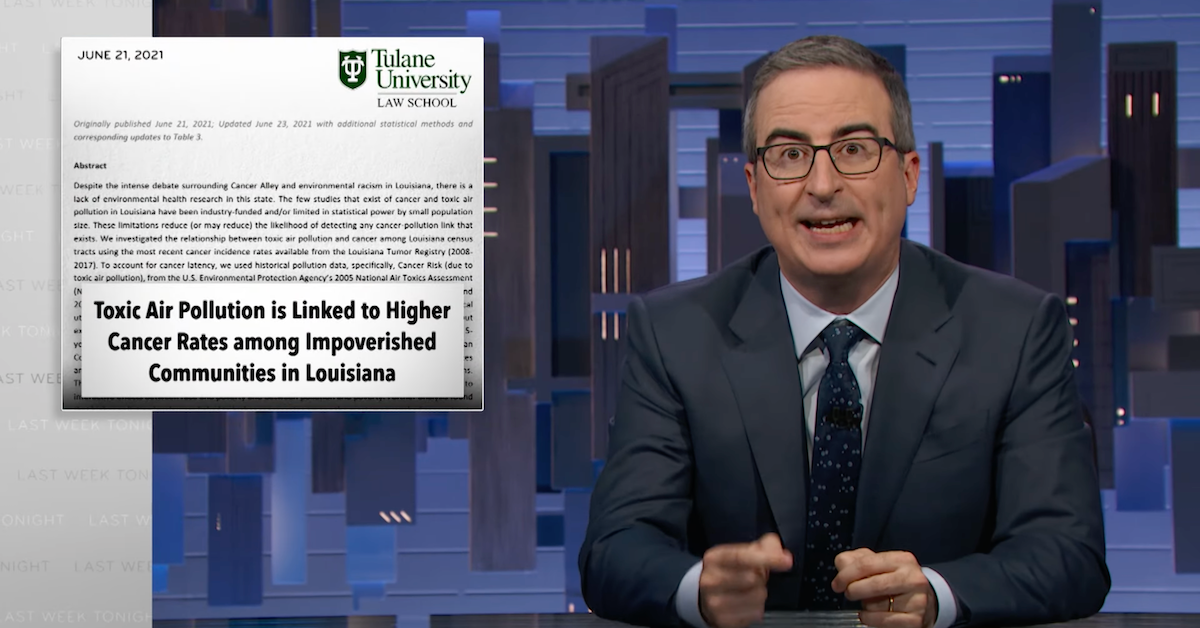John Oliver Breaks Down Environmental Racism in the U.S. on ‘Last Week Tonight’
Published May 2 2022, 4:42 p.m. ET

On Last Week Tonight with John Oliver, the eponymous host is known for taking intimidating, complicated, and hot-button topics, and synthesizing them into concise, easy-to-understand, and hilarious 20-minute television segments. On the newest episode, John Oliver breaks down environmental racism, educating millions of viewers on this issue plaguing the U.S., highlighting how we will never truly tackle the climate crisis without also fighting for climate justice.
The episode aired on Sunday, May 1, 2022, and was uploaded to YouTube on Monday, May 2. By Monday afternoon, the episode had over 1 million views — here are the key takeaways from the Last Week Tonight episode.
What is environmental racism? John Oliver breaks it down.
“We all suffer from exposure to pollution in this country, but some significantly more than others, thanks to what's called environmental racism,” Oliver says in the beginning of the episode.
More specifically, environmental racism is “any policy, practice or directive that differentially affects or disadvantages (where intended or unintended) individuals, groups, or communities based on race,” as author and educator Dr. Robert Bullard defined the term in his book Dumping in Dixie.
Oliver then cites studies which have found that Black Americans are exposed to 38 percent more polluted air, and are 75 percent more likely to live in “communities that border a plant or a factory.” He notes that while sometimes, examples of environmental racism are subtle, more often than not, they are extremely overt and intentional.
‘Last Week Tonight’ looks at environmental racism through the lens of pollution.
Environmental racism affects people of color in a number of ways, and the Last Week Tonight team focused their segment on pollution and health.
“Black neighborhoods in particular can get targeted with incredible precision, and the stakes could not be higher here,” Oliver explains. “Pollution is one of the driving factors behind conditions like heart disease, asthma, and even death, with Black Americans nearly three times as likely to die from exposure to pollution.”
He also plays a clip of Dr. Robert Bullard discussing how zip codes affect public health. Dr. Bullard notes that the life expectancy in some U.S. zip codes is 15 years shorter than in directly adjacent zip codes, “depending on what's in that neighborhood and what's not in that neighborhood.”
What are some examples of environmental racism?
Oliver shares a number of major examples of environmental racism throughout the episode.
He talks about a 2008 coal ash spill in Tennessee, in which tons of toxic waste were dumped into a primarily white area. “The good news is, they removed 4 million tons of it. The bad news is, it was then dumped 300 miles away in this largely Black community called Uniontown,” Oliver says.
The host also discusses Shingle Mountain, the work of a recycling company that dumped hundreds of thousands of tons of roofing shingles in a vacant lot in Dallas, Texas — right next to homes in a primarily Black and Latino neighborhood.
Oliver also mentions the Byhalia Connection Pipeline, a southwest Memphis oil pipeline that was proposed to take a long path through several historically Black communities, rather than take a shorter, more direct path through predominantly white, wealthy neighborhoods. The project was officially canceled in 2021, thanks to the tireless work of protestors and activists.
He details the West Calumet Housing Complex in East Chicago, Indiana, a federally-assisted housing community built on top of a former lead smelter, with highly dangerous lead levels in the ground. “The government knew the area was dangerously toxic decades before they told anyone who lived there,” Oliver says. “Time and again, regulators had the opportunity to tell residents, and they just didn't.”
Oliver also discusses Cancer Alley, a length of land between New Orleans and Baton Rouge, where there are more than 100 petrochemical plants and refineries. Residents of Cancer Alley face a cancer risk of nearly 50 times the national average, according to the EPA.
He also lists a number of unsafe housing projects located on superfund sites. “70 percent of hazardous waste sites on the superfund list are located within one mile of federally assisted housing,” Oliver notes.
Oliver also mentions how, even though President Biden made environmental justice a pillar of his presidential campaign, in February, his administration announced that race will no longer be considered in the fight for environmental justice.
How to fight environmental racism:
Oliver notes that there are two main things the U.S. needs to do to tackle environmental racism. First, we must clean up the messes that the government and pollutive industries and corporations have made — but we must take it much further than that to prevent environmental racism from continuing to flourish.
“This isn't just about cleaning pollution that already happened,” he says. “It's about deciding where industries will be allowed to pollute going forward. And without significant changes, our whole system is currently set up so that places that have already been polluted, get worse and worse.”
Oliver also states that major conservation and environmentalist organizations should lend more support to local activists who are working on the ground to fight against environmental racism. “Maybe conservationists could redirect some of the resources to environmental justice that they've been completely wasting on pandas,” Oliver jokes.
He adds that the government must take more serious action to put an end to this, specifically in the form of “zoning reform, to keep polluters and residents safely apart.”
“When this country designates communities of color as sacrifice zones, the clear message there is that the people who live in them are expendable, that it's okay for their kids to not be able to play outside, and for their lifespans to be shorter,” Oliver says at the end of the segment. “And unless we make big steps to address environmental racism and call it what it is, a brutal divide is going to stay in place in this country where some are treated like they're worth protecting, and others like they can be sacrificed.”
You can watch the episode of Last Week Tonight with John Oliver on YouTube or on HBO Max.
